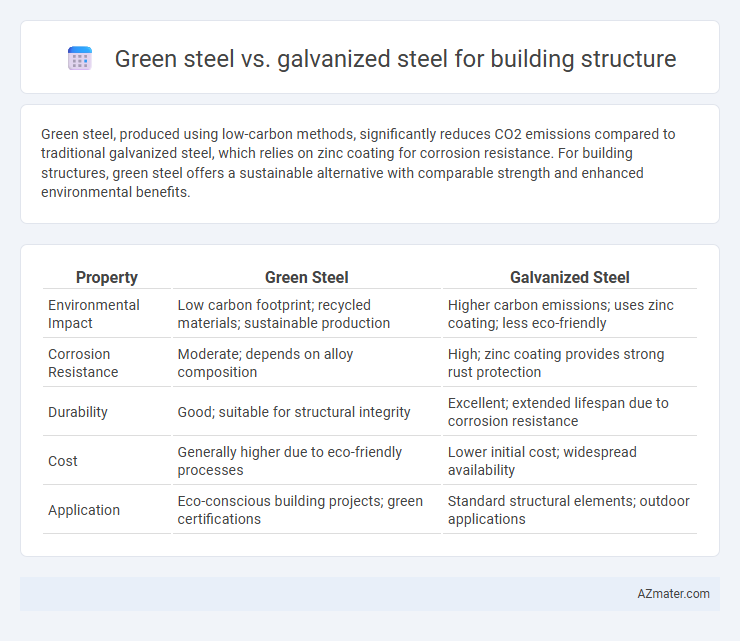Green steel, produced using low-carbon methods, significantly reduces CO2 emissions compared to traditional galvanized steel, which relies on zinc coating for corrosion resistance. For building structures, green steel offers a sustainable alternative with comparable strength and enhanced environmental benefits.
Table of Comparison
| Property | Green Steel | Galvanized Steel |
|---|---|---|
| Environmental Impact | Low carbon footprint; recycled materials; sustainable production | Higher carbon emissions; uses zinc coating; less eco-friendly |
| Corrosion Resistance | Moderate; depends on alloy composition | High; zinc coating provides strong rust protection |
| Durability | Good; suitable for structural integrity | Excellent; extended lifespan due to corrosion resistance |
| Cost | Generally higher due to eco-friendly processes | Lower initial cost; widespread availability |
| Application | Eco-conscious building projects; green certifications | Standard structural elements; outdoor applications |
Introduction to Green Steel and Galvanized Steel
Green steel is produced using environmentally friendly methods that reduce carbon emissions, often involving hydrogen-based direct reduction or electric arc furnaces powered by renewable energy. Galvanized steel is traditional steel coated with a layer of zinc to prevent corrosion, ensuring durability in building structures without significant environmental benefits. Both materials serve structural purposes, but green steel offers a sustainable alternative aligned with evolving green building standards.
Manufacturing Processes Compared
Green steel manufacturing relies on hydrogen-based direct reduction of iron ore, significantly reducing carbon emissions compared to traditional blast furnace methods. Galvanized steel production involves coating conventional steel with a layer of zinc through hot-dip galvanizing or electro-galvanizing, focusing on corrosion resistance rather than emission reduction. The manufacturing process of green steel emphasizes sustainability and lower environmental impact, while galvanized steel centers on enhancing durability for building structures.
Environmental Impact Assessment
Green steel production significantly reduces carbon emissions by utilizing hydrogen or electric arc furnace technology powered by renewable energy, minimizing the environmental footprint compared to traditional steel manufacturing. Galvanized steel, while providing excellent corrosion resistance through zinc coating, involves energy-intensive processes with notable emissions and environmental concerns related to zinc mining and plating waste management. Life cycle assessments reveal green steel offers a substantially lower global warming potential and resource consumption, making it a more sustainable choice for building structures focused on environmental impact reduction.
Structural Performance and Strength
Green steel offers comparable structural performance and strength to galvanized steel while providing enhanced sustainability through lower carbon emissions in production. Galvanized steel features a zinc coating that improves corrosion resistance, ensuring durability in building structures exposed to harsh environments. Both materials deliver high tensile strength and load-bearing capacity, but green steel's environmentally friendly manufacturing process makes it a preferred choice for sustainable construction projects.
Corrosion Resistance and Longevity
Green steel offers enhanced corrosion resistance due to its environmentally friendly manufacturing processes that reduce impurities and improve material density, resulting in prolonged longevity for building structures. Galvanized steel provides a robust zinc coating that effectively prevents rust formation, ensuring durability and extended service life, especially in outdoor and humid environments. Comparing both, green steel often delivers superior corrosion resistance through intrinsic material quality, while galvanized steel relies on its protective coating, impacting maintenance needs and lifespan.
Cost Analysis: Initial and Lifecycle
Green steel typically incurs higher initial costs due to advanced production processes and eco-friendly raw materials, while galvanized steel offers lower upfront expenses because of widespread manufacturing and material availability. Over the lifecycle, green steel can reduce overall costs through energy efficiency, durability, and lower maintenance expenses, offsetting its initial price premium. In contrast, galvanized steel may require more frequent maintenance and replacements, increasing long-term expenditure despite its initial affordability.
Suitability for Sustainable Building Design
Green steel, produced with reduced carbon emissions through innovative methods such as hydrogen-based direct reduction, offers superior sustainability benefits by minimizing environmental impact in building structures. Galvanized steel, coated with zinc for corrosion resistance, provides durability but involves energy-intensive processing and less eco-friendly raw material sourcing. For sustainable building design, green steel aligns more effectively with low-carbon goals, reducing the overall carbon footprint while maintaining structural integrity.
Availability and Supply Chain Considerations
Green steel, produced using low-carbon methods such as hydrogen reduction or electric arc furnaces powered by renewable energy, is currently less available and has a limited supply chain compared to galvanized steel due to the nascent stage of green steel production technologies and infrastructure. Galvanized steel benefits from an extensive, mature global supply chain with established manufacturing facilities and widespread distribution networks, ensuring consistent availability for building structure applications. Challenges in scaling green steel production and sourcing raw materials sustainably contribute to supply chain uncertainties, impacting project planning and cost predictability relative to galvanized steel.
Industry Standards and Certifications
Green steel and galvanized steel both meet rigorous industry standards such as ASTM A36 for structural steel and ASTM A123 for galvanizing. Green steel emphasizes environmentally certified production processes, often adhering to ISO 14001 for sustainable manufacturing and LEED certification criteria for green building projects. Galvanized steel ensures corrosion resistance through zinc coating conforming to standards like ASTM A153, enhancing longevity in structural applications while maintaining compliance with industry safety and quality certifications.
Future Trends in Structural Steel Solutions
Green steel, produced using low-emission processes such as hydrogen reduction, is poised to revolutionize building structures by significantly reducing the carbon footprint compared to traditional steel. Galvanized steel remains essential for corrosion resistance, but future structural steel solutions increasingly integrate green steel with advanced coatings to enhance durability and sustainability. Emerging trends also emphasize circular economy principles, with recycled green steel and improved galvanizing techniques driving eco-friendly, resilient building frameworks.

Infographic: Green steel vs Galvanized steel for Building structure
 azmater.com
azmater.com